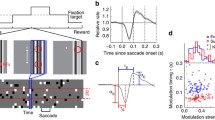Abstract
The primate visual cortex exhibits two anatomically distinct pathways (dorsal and ventral). According to the “two visual systems hypothesis” (TVSH) of Milner and Goodale (The visual brain in action. Oxford University Press, Oxford, 1995), this anatomical distinction corresponds to a functional division of labor between vision-for-action (dorsal) and vision-for-perception (ventral). This proposal is supported by evidence that, in healthy volunteers, perceptual responses are affected by visual illusions, whereas motor responses to the same illusion-inducing stimuli are not. However, previously we have shown that the amplitude of saccadic eye movements is modified by the Müller–Lyer illusion in a similar manner as perceptual responses. Here we extend this finding to reflexive and voluntary (memory-guided) saccades. We show that both types of saccade can be strongly affected by the illusion. In our studies, the effect on reflexive saccades was comparable to that usually observed with verbal reports (an effect size of 22 ± 8%), whereas the effect on voluntary saccades was smaller (11 ± 11%). In addition, both types of saccade provide evidence for the scaling bias usually observed in perceptual responses. We suggest that previous studies may have employed methods that generally reduced the effect of the illusion. Interpretations of dissociations between reflexive and voluntary saccades in terms of the TVSH appear to be premature.







Similar content being viewed by others
References
Bernardis P, Knox P, Bruno N (2005) How does action resist visual illusion? Uncorrected oculomotor information does not account for accurate pointing in peripersonal space. Exp Brain Res 162:133–144
Binsted G, Elliot D (1999) The Muller–Lyer illusion as a perturbation to the saccadic system. Hum Movement Sci 18:103–117
Bradshaw MF, Watt SJ (2002) A dissociation of perception and action in normal human observers: the effect of temporal delay. Neuropsycholgia 40:1766–1778
Brown MRG, DeSouza JFX, Goltz HC, Ford K, Menon RS, Goodale MA, Everling S (2004) Comparison of memory- and visually guided saccades using event-related fMRI. J Neurophysiol 91:873–889
Bruno N (2001) When does action resist visual illusions? TICS 5:385–388
Bruno N, Bernadis P (2002) Dissociating perception and action in Kanizsa’s compression illusion. Psychon Bull Rev 9:723–730
Bruno N, Bernardis P (2003) When does action resist visual illisions? Effector position modulates illusory influences on motor responses. Exp Brain Res 151:225–237
Carey DP (2001) Do action systems resist visual illusions? TICS 5:109–113
de Grave D, Smeets J, Brenner E (2006a) Why are saccades influenced by the Brentano illusion? Exp Brain Res 175:177–182
de Grave DDJ, Franz VH, Gegenfurtner KR (2006b) The influence of the Brentano illusion on eye and hand movements. J Vis 6:727–738
Fischer B, Weber H (1992) Characteristics of “anti” saccades in man. Exp Brain Res 89:415–424
Fischer B, Weber H (1993) Express saccades and visual attention. Behav Brain Sci 16:553–610
Franz VH (2001) Action does not resist visual illusions. TICS 5:457–459
Franz VH, Gergenfurtner KR, Bulthoff HH, Fahle M (2000) Grasping visual illusions: no evidence for a dissociation between percpetion and action. Psychol Sci 11:20–25
Goodale MA, Westwood DA (2004) An evolving view of duplex vision: separate but interacting cortical pathways for perception and action. Curr Opin Neurobiol 14:203–211
Hallett P (1978) Primary and secondary saccades to goals defined by instructions. Vis Res 18:1279–1296
Hu Y, Eagleson R, Goodale MA (1999) The effects of delay on the kinematics of grasping. Exp Brain Res 126:109–116
Jeannerod M, Jacob P (2005) Visual cognition: a new look at the two-visual systems model. Neuropsychologia 43:301–312
Knox PC (2006) The effect of Kanizsa’s compression illusion on reflexive saccades. Exp Brain Res 175:764–768
Krauzlis RJ, Miles FA (1996) Release of fixation for pursuit and saccades in humans: evidence for shared inputs acting on different neural substrates. J Neurophysiol 76:2822–2833
Machado L, Rafal R (2000) Control of eye movement reflexes. Exp Brain Res 135:73–80
McCarley JS, Kramer AF, DiGirolamo GJ (2003) Differential effects of the Muller–Lyer illusion on reflexive and voluntary saccades. J Vis 3:751–760
Melcher D, Kowler E (1999) Shapes, surfaces and saccades. Vis Res 39:2929–2946
Milner D, Dyde R (2003) Why do some perceptual illusions affect visually guided action, when others don’t? TICS 7:10–11
Milner AD, Goodale MA (1995) The visual brain in action. Oxford University Press, Oxford
Munoz DP (2002) Commentary: saccadic eye movements: overview of neural circuitry. Prog Brain Res 140:3–19
Musseler J, Heijden AHCvd, Kerzel D (2004) Visual space perception and action: introductory remarks. Vis Cogn 11:129–136
Pavani F, Boscagli I, Benvenuti F, Rabuffetti M, Farnè A (1999) Are perception and action affected differently by the Titchener circles illusion? Exp Brain Res 127:95–101
Pierrot-Deseilligny C, Müri RM, Rivaud-Pechoux S, Gaymard B, Ploner CJ (2002) Cortical control of spatial memory in humans: the visuooculomotor model. Ann Neurol 52:10–19
Pratt J, Bekkring H, Abrams RA, Adam J (1999) The gap effect for spatially oriented responses. Acta Psychol 102:1–12
Prochazka A, Clarac F, Loeb GE, Rothwell JC, Wolpaw JR (2000) What do reflex and voluntary mean? Modern views on an ancient debate. Exp Brain Res 130:417–432
Rizzolatti G, Matelli M (2003) Two different streams form the dorsal visual system: anatomy and functions. Exp Brain Res 153:146–157
Ungerleider LG, Mishkin M (1982) Two cortical visual systems. In: Ingle DJ, Goodale MA, Mansfield RJW (eds) Analysis of visual behaviour. MIT, Cambridge, pp 549–586
Walker R, Deubel H, Schneider WX, Findlay JM (1997) Effect of remote distractors on saccade programming: evidence for an extended fixation zone. J Neurophysiol 78:1108–1119
Walker R, Walker DG, Husain M, Kennard C (2000) Control of voluntary and reflexive saccades. Exp Brain Res 130:540–544
Wong E, Mack A (1981) Saccadic programming and perceived location. Acta Psychol 48:123–131
Author information
Authors and Affiliations
Corresponding author
Rights and permissions
About this article
Cite this article
Knox, P.C., Bruno, N. When does action resist visual illusion? The effect of Müller–Lyer stimuli on reflexive and voluntary saccades. Exp Brain Res 181, 277–287 (2007). https://doi.org/10.1007/s00221-007-0927-y
Received:
Accepted:
Published:
Issue Date:
DOI: https://doi.org/10.1007/s00221-007-0927-y




